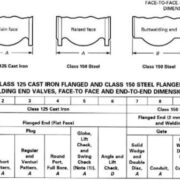Einbaumaße von Flanschventilen ASME B16.10
Wie groß ist die Baulänge eines Kugel-, Durchgangs- oder Absperrschiebers mit Flansch? Der ASME B16.10 Das Diagramm beantwortet diese Frage, da es den Abstand zwischen Einlass und Auslass der gängigsten Flanschventile standardisiert. Der Zweck dieser ASME-Spezifikation besteht darin, die Austauschbarkeit von Ventilen verschiedener Hersteller sicherzustellen.
Anmerkungen:
- (1) Nur Kugel- und Horizontalhubprüfung.
Das Baulängen- und End-zu-Ende-Maß für Rückschlagventile mit Stahlflansch der Klasse 150 in NPS 5 beträgt 330 und in NPS 6 356. - (2) Nur Kugel- und Horizontalhubprüfung.
Das Baulängen- und Endmaß für Rückschlagventile mit Flansch aus Stahl der Klasse 150 in NPS 16 beträgt 864. - (3) Nur Swing-Check.
Allgemeine Hinweise:
- Sofern nicht anders angegeben, sind die Abmessungen in Millimetern angegeben.
- Die Face-to-Face-Dimension für Flanschventile ist der Abstand zwischen den äußersten Enden, die die Kontaktflächen der Dichtung darstellen.
- Die End-to-End-Abmessungen gelten für Flanschventile, bei denen sich die Dichtungskontaktflächen nicht an den äußersten Enden des Ventils befinden. Der Abstand zwischen den äußersten Enden wird als End-to-End-Abmessung bezeichnet und gilt für Flanschventile wie: Ringgelenk, großes oder kleines Innengewinde und große oder kleine Nut.



